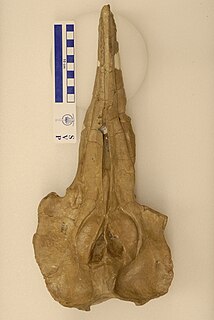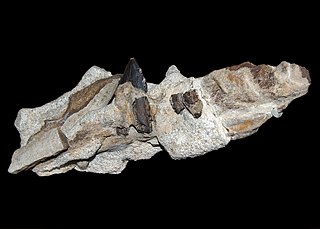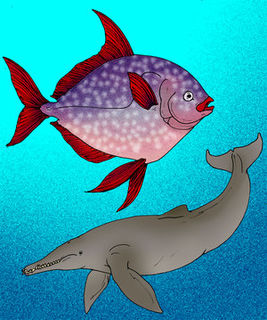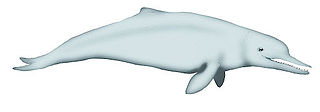 W
WAcrophyseter is a genus of extinct sperm whales that lived in the Late Miocene off the coast of Peru comprising two species: A. deinodon and A. robustus. It is part of a group of macroraptorial sperm whales which all shared several features for the purpose of hunting large prey, such as deeply-rooted and thick teeth. Acrophyseter measured 3.9–4.3 metres (13–14 ft), making it the smallest raptorial sperm whale. Because of its short pointed snout, and its strong curved front teeth, it probably fed on the large marine vertebrates of its time, such as seals and other whales.
 W
WAlbicetus is a genus of stem-sperm whales that lived during the Miocene Epoch, around 15 million years ago, and was discovered in Santa Barbara, California in 1909. It was categorized for decades as belonging to a group of extinct walruses erroneously thought to be sperm whales. It was named Albicetus, meaning "white whale", is a reference to the leviathan in Herman Melville's classic 1851 novel Moby-Dick.
 W
WAllodelphis is an extinct genus of whale belonging to Allodelphinidae found in marine deposits of the eastern North Pacific.
 W
WAnkylorhiza is an extinct genus of toothed whale that lived in what is now the United States during the Oligocene epoch, between 29 and 23.5 million years ago. The type and only known species is A. tiedemani, though two fossil skeletons may represent an additional, second species within the genus. Ankylorhiza was about 4.8 meters (16 ft) long, with a long, robust skull bearing conical teeth that were angled forwards at the tip of the snout.
 W
WArktocara is an extinct genus of river dolphin from the Oligocene epoch of Alaska, containing one species, A. yakataga. Having been discovered in 25-million-year-old strata near the 60th parallel north, it is perhaps the oldest known crown toothed whale and the northmost river dolphin discovered. It was a member of the now-extinct family Allodelphinidae, along with the genera Allodelphis, Goedertius, Ninjadelphis, and Zarhinocetus. It measured approximately 2.26 or 2.28 meters, comparable to its closest living relative, the South Asian river dolphin, which measures 2.4 meters (7.9 ft). However, the animal probably had an elongated beak and neck, so it may have been longer. The animal is known only from a partially preserved skull. Its ecology may have been similar to the modern day Dall's porpoise, and it may have competed with contemporaneous delphinoids. Its remains were found in the Poul Creek Formation, which has also yielded several mollusk species.
 W
WAtocetus is an extinct genus of pontoporiid dolphin found in Miocene-age marine deposits in Peru and California.
 W
WAulophyseter is an extinct genus of sperm whales from the Miocene formations of the west and east coasts of North America.
 W
WAustralodelphis mirus is an extinct Pliocene dolphin. A. mirus is known from fossils found in the Sørsdal Formation, Mule Peninsula, Vestfold Hills, East Antarctica. The genus has been described as an example of convergent evolution with beaked whales.
 W
WThe blunt-snouted dolphin is a prehistoric pilot whale known from a single specimen, consisting of a partial rostrum, partial maxilla, partial premaxilla, and partial vomer. The fossil was discovered by Albert Hoekman on board a fishing trawler in the North Sea in 2008 and described in 2010 by Klaas Post and Erwin J.O. Kompanje. The blunt-snouted dolphin is believed to have had a balloonlike structure atop its rostrum and is estimated to have lived during the middle Pliocene to early Pleistocene.
 W
WBrygmophyseter, known as the biting sperm whale, is an extinct genus of toothed whale in the sperm whale family with one species, B. shigensis. When it was first described in 1994, the species was placed in the genus Scaldicetus based on tooth morphology, but this was later revised in 1995. In 2006, it was classified into the genus Naganocetus, which is considered to be a junior synonym. The only known specimen, a nearly complete skeleton, was dated to be around 14–15 million years old. Brygmophyseter is thought to have been 7 meters (23 ft) long, and it probably had 11 or 12 teeth in the upper and lower jaws. Brygmophyseter is part of a group of macroraptorial sperm whales which tended to be apex predators using their large teeth to catch struggling prey such as whales. It had a spermaceti organ which was probably used for biosonar like in the modern sperm whale. The whale has made an appearance on The History Channel's TV series Jurassic Fight Club.
 W
WChoneziphius is an extinct genus of ziphiidae cetaceans, with two species known from the Miocene: C. planirostris and C. leidyi.
 W
WDenebola is an extinct genus of whale belonging to the family Monodontidae. It contains a single known species, Denebola brachycephala. It is the earliest known ancestor of the beluga, Delphinapterus leucas, and dates from the Upper Miocene period. A fossil was found in the Baja California peninsula, indicating that the family once existed in warmer waters.
 W
WDiaphorocetus is an extinct genus of odontocete cetacean belonging to Physeteroidea. Its remains were found in the Monte León Formation of Argentina, dating to the Early Miocene.
 W
WEtruridelphis is an extinct genus of cetacean.
 W
WEurhinodelphinidae is an extinct family of toothed whales which lived from the Oligocene to the Miocene. Members of the family possessed an elongated jaw similar in appearance to a swordfish.
 W
WEurhinodelphis is an extinct genus of Miocene cetacean. Its fossils have been found in Belgium, France, and Maryland.
 W
WHemisyntrachelus is an extinct genus of cetacean.
 W
WKentriodontidae is an extinct family of odontocete whales related to modern dolphins. The Kentriodontidae lived from the Oligocene to the Pliocene before going extinct.
 W
WLivyatan is an extinct genus of macroraptorial sperm whale containing one known species: L. melvillei. The genus name was inspired by the biblical sea monster Leviathan, and the species name by Herman Melville, the author of the famous novel Moby Dick about a white bull sperm whale. It is mainly known from the Pisco Formation of Peru during the Tortonian stage of the Miocene epoch, about 9.9–8.9 million years ago (mya); however, finds of isolated teeth from other locations such as Chile, Argentina, South Africa, and Australia imply that either it or a close relative survived into the Pliocene, around 5 mya, and was present throughout the Southern Hemisphere. It was a member of a group of macroraptorial sperm whales and was probably an apex predator, preying on whales, seals, and so forth. Characteristically of raptorial sperm whales, Livyatan had functional, enamel-coated teeth on the upper and lower jaws, as well as several features suitable for hunting large prey.
 W
WLophocetus is an extinct genus of dolphin belonging to the clade Delphinida that is known from late Miocene (Tortonian) marine deposits in California and Maryland. Although usually placed in Kentriodontidae, recent studies have found it only distantly related to Kentriodon.
 W
WMacrodelphinus is an extinct genus of primitive odontocete known from Late Oligocene (Chattian) marine deposits in California.
 W
WMacroraptorial sperm whales were highly predatory whales of the sperm whale family (Physeteroidea) of the Miocene epoch that hunted large marine mammals, including other whales, using their large teeth. They were all likely the apex predator of their habitats, comparable to the modern day killer whale, and achieved great lengths, with one species–Livyatan–measuring about 13.5–17.5 metres (44–57 ft). The macroraptorial sperm whales–Albicetus, Acrophyseter, Brygmophyseter, Livyatan, Scaldicetus, and Zygophyseter–are an informal grouping of genera without a family designation. All species are known by at least a skull.
 W
WNeosqualodon is an extinct genus of toothed cetacean, that lived in the modern Italy in the Middle Miocene (Langhian). Their fossils - mostly teeth and jaws - have been recovered in the Ragusa Formation of Sicily, that are more robust and shorter than in the related genus Squalodon. Two species are known: N. assenzae and N. gemellaroi, that are distinguished by the shape of the teeth. Apparently this genus was endemic of the pre-Mediterranean sea of the Late Oligocene.
 W
WOdobenocetops is an extinct genus of small toothed whale known from Peru and Chile. Its fossils are found in Neogene-aged marine strata dating from the Tortonian to the Zanclean. It had two tusks, and, in some fossils, one tusk was longer than the other.
 W
WOrcinus citoniensis is an extinct species of killer whale identified in the Late Pliocene of Italy and the Early Pleistocene of England. It was smaller than the modern killer whale, 4 m (13 ft) versus 7 to 10 m, and had around 8 more teeth in its jaw. It may have resembled the modern killer whale in appearance, and could represent a transitional species between the modern killer whale and other dolphins. O. citoniensis may have hunted large fish and squid in pods, and coexisted with other large predators of the time such as the orcinine Hemisyntrachelus and the extinct shark Otodus megalodon.
 W
WOrycteocetus is an extinct genus of sperm whale from the Miocene of the northern Atlantic Ocean.
 W
WOtekaikea is an extinct genus of toothed whale closely related to Waipatia. It is known from the late Oligocene (Chattian) of New Zealand.
 W
WParapontoporia is an extinct genus of dolphin that lived off the Californian coast from the Late Miocene until the genus' extinction during the Pliocene. It is related to the baiji.
 W
WPatriocetus is an extinct genus of toothed whale.
 W
WProsqualodon is an extinct genus of Early to Middle Miocene cetacean from Argentina, Australia, New Zealand and Venezuela.
 W
WRudicetus is an extinct genus of cetacean.
 W
WScaldicetus is an extinct genus of highly predatory macroraptorial sperm whale. Although widely used for a number of extinct physeterids with primitive dental morphology consisting of enameled teeth, Scaldicetus as generally recognized appears to be a wastebasket taxon filled with more-or-less unrelated primitive sperm whales.
 W
WSemirostrum ceruttii is an extinct porpoise that lived between 5 and 1.5 million years ago (Ma), during the Pliocene epoch. The species is highly distinctive due to the extremely long symphysis on the lower jaw, reaching lengths of 85 centimeters (33.46 inches), while that of a modern porpoise are 1–2 centimeters (0.39–0.79 inches) long. The main hypothesis regarding its use is that it probed along the sediment in the murky estuaries and shores of what is now California in search of food, which would easily be scooped up the symphysis and into the jaws. The etymology of the name means "half beak", referring to the upper jaw being half the length of the lower.
 W
WSqualodon is an extinct genus of whales of the Oligocene and Miocene epochs, belonging to the family Squalodontidae. Named by Jean-Pierre Sylvestre de Grateloup in 1840, it was originally believed to be an iguanodontid dinosaur but has since been reclassified. The name Squalodon comes from Squalus, a genus of shark. As a result, its name means "shark tooth." Its closest modern relative is the South Asian river dolphin.
 W
WSqualodontidae or the shark-toothed dolphins is an extinct family of large toothed whales who had long narrow jaws. Squalodontids are known from all continents except Antarctica, from the Oligocene to the Neogene, but they had a maximal diversity and global distribution during the Late Oligocene and Early to Middle Miocene.
 W
WWaipatia is an extinct genus of whale from the late Oligocene (Chattian) of New Zealand.
 W
WXenorophidae is an extinct family of odontocetes currently known from the Oligocene of the southeastern US. Known genera of xenorophids include Albertocetus, Archaeodelphis, Cotylocara, Echovenator, Inermorostrum, and Xenorophus.
 W
WXiphiacetus is an extinct genus of cetacean known from the Miocene (early Burdigalian to late Tortonian, 20.43 to 7.246 million years ago of Europe and the U.S. East Coast.
 W
WZygophyseter varolai is an extinct sperm whale that lived during the Tortonian age of the Late Miocene 11.2 to 7.6 million years ago. It is known from a single specimen from the Pietra Leccese Formation in Italy. It was a member of a stem group of fossil macroraptorial sperm whales also including Brygmophyseter, Acrophyseter, and Livyatan. It probably grew to be around 6.5 to 7 meters in length and shared some characteristics with other raptorials, such as large teeth with tooth enamel that were functional in both the upper and lower jaws which the modern sperm whale lacks. It also had a beak, the ability to echolocate prey, and could have probably swum faster than the modern-day sperm whale which goes 4 kilometers per hour (2.5 mph). These were probably used in the capture of large prey, such as large fish, seals, and whales. In fact, its common name, the killer sperm whale, refers to its feeding habits that would have had a resemblance to the modern-day killer whale.